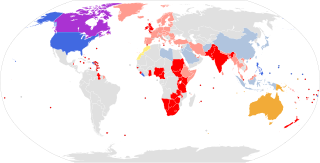Definition
This section's tone or style may not reflect the encyclopedic tone used on Wikipedia.(February 2020) |
In simple terms, a transition word demonstrates the relationship between two portions of a text or spoken language. By using these words, people can better build a sentence and convey what they are trying to say in a more concise manner. [3]
Coordinating transitions
Elements in a coordinate relationship are equal in rank, quality, or significance. [4] They help to show a link between equal elements. [5]
- To show similarity or reinforce: also, and, as well as, by the same token, comparatively, correspondingly, coupled with, equally, equally important, furthermore, identically, in the light of, in the same fashion/way, likewise, moreover, not only... but also, not to mention, similarly, to say nothing of, together with, too, uniquely
- To introduce an opposing point: besides, but, however, in contrast, neither, nevertheless, nor, on the contrary, on the other hand, still, yet [5]
- To signal a restatement: [6] in other words, in simpler terms, indeed, that is, to put it differently
Subordinating transitions
- To introduce an item in a series: [7] finally, first, for another, for one thing, in addition, in the first place, in the second place, last, next, second, then [8]
- To introduce an example: [9] for example, for instance, in particular, namely, specifically, that is
- To show causality: accordingly, as a result, because, consequently, for, hence, since, so, then, therefore, thus
- To introduce a summary or conclusion: [7] actually, all in all, altogether, clearly, evidently, finally, in conclusion, of course, to sum up
- To signal a concession: [9] certainly, granted, it is true, naturally, of course, to be sure
- To resume main argument after a concession: all the same, even though, nevertheless, nonetheless, still
Temporal transitions
- To show frequency: again and again, day after day, every so often, frequently, hourly, now and then, occasionally, often
- To show duration: briefly, during, for a long time, minute by minute, while
- To show a particular time: at six o'clock, at that time, first thing in the morning, in 1999, in the beginning of August, in those days, last Sunday, next Christmas, now, then, two months ago, when
- To introduce a beginning: at first, before then, in the beginning, since
- To introduce a middle: as it was happening, at that moment, at the same time, in the meantime, meanwhile, next, simultaneously, then
- To signal an end (or beyond): afterward/afterwards, at last, eventually, finally, in the end, later
Spatial transitions
- To show closeness: adjacent to, alongside, close to, facing, near, next to, side by side
- To show long distance: away, beyond, far, in the distance, there
- To show direction: above, across, along, away from, behind, below, down, in front of, inside, outside, sideways, to the left, to the right, toward/towards, up
Transition words of agreement, addition, or similarity
The transition words, such as also, in addition, and likewise, add information, reinforce ideas, and express agreement with preceding material. [10]
- additionally
- again
- also
- and
- as
- as a matter of fact
- as well as
- by the same token
- comparatively
- correspondingly
- coupled with
- equally
- equally important
- first
- furthermore
- identically
- in addition
- in like manner
- in the first place
- in the light of
- in the same fashion/way
- like
- likewise
- moreover
- not only ... but also
- not to mention
- of course
- second
- similarly
- then
- third
- to
- to say nothing of
- together with
- too
- uniquely
- what's more





